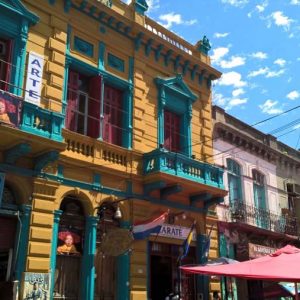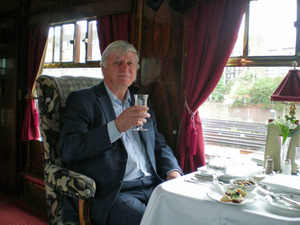 I love trains. This can be an awkward thing to admit in certain company but I’m no anorak train spotter and I don’t have a model train set in the attic – I just love everything about travelling by train.
I love trains. This can be an awkward thing to admit in certain company but I’m no anorak train spotter and I don’t have a model train set in the attic – I just love everything about travelling by train.
They have so much more to offer the traveller than simply getting from A to B; great train journeys are adventures in themselves, invariable generating good memories & can be a holiday in themselves. As for flying, that’s invariably best forgotten, my only memorable flight is years ago being bumped up to business class on a 14-hour flight from Tokyo. The best of the rest are just a fog of mindless tedium and the worst are horrors buried too deep in my subconscious to mention. As for boats & cruises my abiding memory is watching lunch disappearing over the side & debating whether I should join it.
I’m not talking about crowded commuter trains but great railway journeys – grand excursions through novel and exotic landscapes, meeting people from various walks of life and relaxing in spacious comfort. Maybe dining on champagne & caviar or buying home made pirozhki (a savoury pie) for a few pence from a babushka at a brief station halt in Siberia.
Trains are no longer the preserve of those who can’t afford to fly or the train spotter obsessed with locomotive engine numbers. Rail travel has been rediscovered by modern, eco-friendly travellers who want to see more from the window than the tops of clouds.
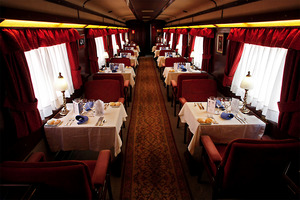 Rail travel doesn’t have the monotonous uniformity of air travel nor are you processed like a piece of cargo, to be strapped into a seat until you can be off-loaded at the other end. Maybe you think that because trains are stuck on tracks the scope for exploration is limited but the choice of rail travel possibilities are vast – you could travel fast or slow, active or lazy, five star or two star, luxury dining or picnic style, meet locals or travel on group trips.
Rail travel doesn’t have the monotonous uniformity of air travel nor are you processed like a piece of cargo, to be strapped into a seat until you can be off-loaded at the other end. Maybe you think that because trains are stuck on tracks the scope for exploration is limited but the choice of rail travel possibilities are vast – you could travel fast or slow, active or lazy, five star or two star, luxury dining or picnic style, meet locals or travel on group trips.
If its slow and historic that appeals then the North Yorkshire Moors Railway would be hard to beat. Built by George Stephenson himself the Whitby to Pickering steam railway line, opened in 1836. Trains on this route criss-cross the River Esk as they puff their way uphill though woodland to the quintessential Victorian station of Goathland. You might find that Goathland (aka Aidensfield or Hogsmeade) and its surrounding scenery are familiar if you’ve seen the TV series Heartbeat or Harry Potter and the Philosopher’s Stone. Onwards from Goathland the train climbs onto wild heather clad moorland, crossing bogs and passing old lead mines until finally pulling in to the historic market town of Pickering.
You don’t have to go far for a taste of luxury. The fabulous Simplon-Orient-Express still goes to Venice but it also makes several Lordly processions around the UK. You can re-live a magical moment in history in the Pullman carriages that transported kings, politicians, artists and courtesans, during the golden age of travel. Relaxing in a sumptuous armchair and admiring the intricate marquetry, woven brass luggage racks, gleaming crystal and silken lampshades whilst sipping champagne and being served a five course gourmet lunch.
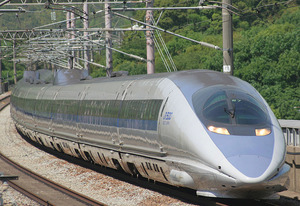 But if it’s speed and modernity you relish then the Nozomi – Japan’s bullet train hurtling along at 186 mph is for you. They don’t look like any train you’ve ever seen – because they’re not. At 186mph the ride is so smooth you can stand a coin on the table and it won’t topple over.
But if it’s speed and modernity you relish then the Nozomi – Japan’s bullet train hurtling along at 186 mph is for you. They don’t look like any train you’ve ever seen – because they’re not. At 186mph the ride is so smooth you can stand a coin on the table and it won’t topple over.
The Tokyo to Osaka Nozomi will get you to your destination before air passengers have settled into their seat at Tokyo’s Narita airport. Its punctuality is mind blowing, consistently arriving within six seconds of its scheduled timetable. On a clear day you flash past Mount Fuji but what I liked most were the ultra-smart carriage attendants who bow to passengers as they enter and leave the carriage and of course the bento boxes of sushi which outclass a curling ham sandwich every time.
But perhaps you’re more into epic journeys; in that case the Trans-Mongolian route is in a league of its own. Covering 5,000 mile and taking seven days this journey starts in Moscow, crosses the Urals and leaves Europe for Siberia, it then bears south into Mongolia and east, across the Great Wall, into China, terminating at Beijing. The time on the train is always Moscow time no matter what the clock on the platform says.
But if the thought of seven days straight travel is unbearable there are plenty of hop on and off options. You could pause at Yekaterinburg and ghoulishly visit the site where Tsar Nicholas and the entire Romanov family were murdered, or Irkutsk to explore the incomparably vast Lake Baikal. 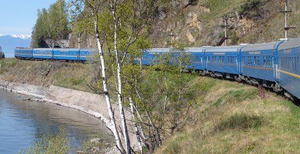 Then there’s Mongolia’s capital, Ulan Bator, the vast rolling Steps and the formidable Gobi desert. As for accommodation you could travel cattle class sleeping along with 30 odd other travellers or book 4 berth or 2 berth cabins but if you don’t want to experience the hurly burly of local cultures there are a number of luxury private trains – at a premium price.
Then there’s Mongolia’s capital, Ulan Bator, the vast rolling Steps and the formidable Gobi desert. As for accommodation you could travel cattle class sleeping along with 30 odd other travellers or book 4 berth or 2 berth cabins but if you don’t want to experience the hurly burly of local cultures there are a number of luxury private trains – at a premium price.
If epic journeys are not your thing, perhaps you would prefer record breaking train journeys? The Euro tunnel connecting Britain and France has been voted one of the seven wonders of the modern world. It’s the longest & deepest undersea train journey & connects the two capital cities in just over two hours. Scheduled flights between London & Paris have understandably plummeted as who in their right mind would fly when you could complete the journey in the time it normally takes to check-in.
The Eurostar train also travels from city centre to city centre as opposed to – miles out in the suburbs to miles out in the suburbs; its far more spacious than an aircraft and culinary choices range from bubble and squeak to Belgian waffles. Trains depart every hour and as you belt along at 186mph there’s barely enough time to enjoy the rolling countryside of Kent and Picardy.
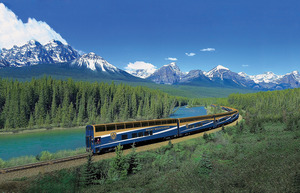 But if undersea trains are off-putting, consider the opposite extreme and ascend to 4,829 metres while crossing the Andes from Lima to Huancayo on the Central Andean railway in Peru.
But if undersea trains are off-putting, consider the opposite extreme and ascend to 4,829 metres while crossing the Andes from Lima to Huancayo on the Central Andean railway in Peru.
That’s nearly four times the height of Ben Nevis (1,343 metres). Aircrafts need to provide oxygen above 3,600 metres so there’s a danger of altitude sickness but the onboard nurse can provide a puff from the oxygen cylinders to those that need it. This twelve-hour journey is so steep that the track zigzags like a fairground ride across 66 bridges and through its 59 tunnels.
Coca is the standard local remedy for altitude sickness and coca tea is served throughout the journey although many locals still prefer the traditional option of chewing coca leaves – the raw form of cocaine.
The landscape is not chocolate box scenery, its starkly brutal, forbidding and desolate – beautiful in its way – but very little can survive at this altitude apart from the condors. But if you have high blood pressure or heart problems it might want to give this one a miss.
If you can’t organise one of these great journeys just now, you could do some armchair travelling with the book Great Train Journeys of the World. It’s a fascinating collection of 40 great railway journeys from around the world. It’s not the usual coffee table picture book (although it does include some great photography) nor is it a disguised sales brochure; it’s about exotic journeys with insider tips, practical details and is written by travel writers who have been there and done it. My small contribution to the book is the fabulous Indian-Pacific route from Sydney to Perth.
For more information about Rail travel, read Peter Lynch’s Blog
Read a review about the ‘Watercress Line’
Silver Travel Advisor recommends Great Rail Journeys


